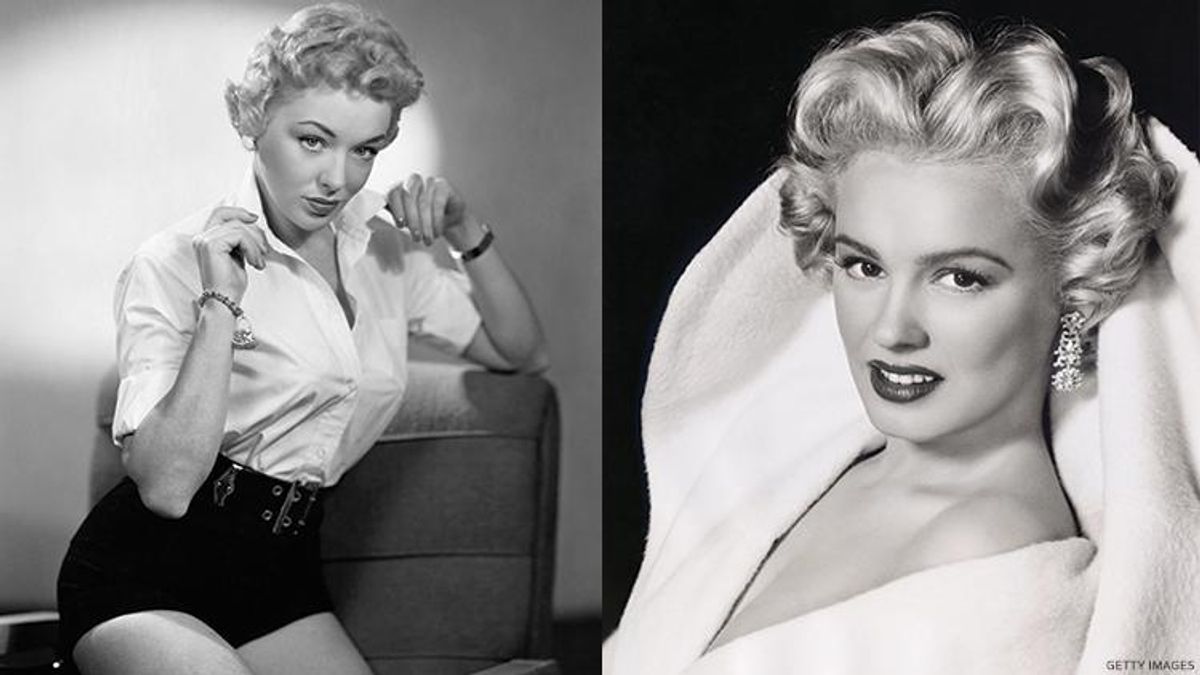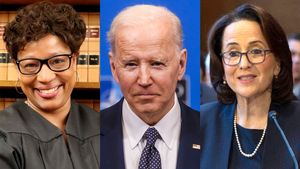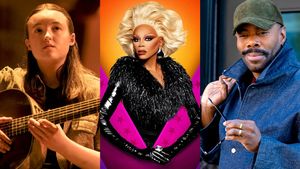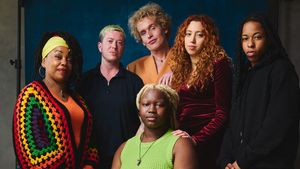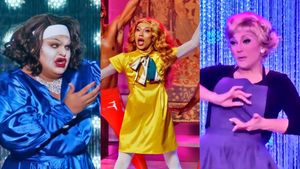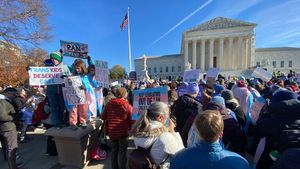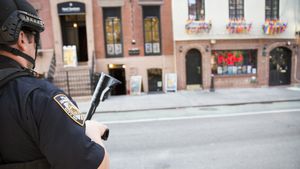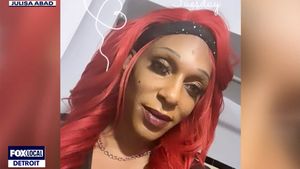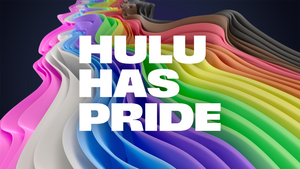Vivian Blaine (pictured above left), who originated the role of Miss Adelaide in the iconic 1950 Broadway musical Guys and Dolls (and who would have turned 100 this year), is never listed among Hollywood’s early AIDS warriors. But she deserves to be.
In 1983, press agent and off-Broadway producer Alan Eichler — whose YouTube channel is a wealth of stage, TV, movie, and music rarities — came up with the idea of organizing a star-studded fundraiser that wound up being the first theatrical AIDS benefit on the West Coast.
Eichler, who had been a press agent for Hello, Dolly! and Hair, was known for working with ladies of a certain age who he hoped to, and often did, restore to their former glory: Yma Sumac, Eartha Kitt, Patti Page.
He also worked closely with Tom Eyen, the playwright and lyricist who, in 1982, enjoyed a smash with Broadway’s Dreamgirls. In 1975, Eyen had written the camp play Women Behind Bars, a raunchy parody of prison exploitation films that served as a vehicle for plus-size Halston model Pat Ast and midnight movie star Divine, and a new production at the Roxy on the Sunset Strip in L.A. was taking off with Adrienne Barbeau, Sharon Barr, and Lu Leonard.
A friend of Eichler’s, a VJ at the gay bar Revolver, told him that a newly formed organization — which became AIDS Project Los Angeles and is now APLA Health — was having no luck attracting stars to call attention to the runaway AIDS crisis.
“They weren’t able to get anybody to do anything — nobody wanted to be associated with the word ‘AIDS.’ Even the so-called gay stars like Bette Midler or Diana Ross, none of them wanted to be associated with that word,” Eichler recalls.
This conversation led him to think about the resources at his own fingertips. “I thought, Here I am with these older stars. If the [younger] stars don’t want to tarnish their names with AIDS, the older stars have nothing to lose.”

Why not enlist older stars in the fight against HIV — and do it using Women Behind Bars, which already had a gay-friendly audience? Because it was written by Eyen as a valentine to shady ladies of the silver screen, Eichler decided to invite actresses from ’50s movies to make a special appearance at the end of a performance, and then donate all proceeds to HIV charities.
It was natural that the first person Eichler asked was Vivian Blaine. He was in the midst of helping the woman once known as 20th Century Fox’s “Cherry Blonde” with a cabaret act. New Jersey-born Blaine had been a big-band singer, worked with Laurel & Hardy, introduced standards like “I Don’t Care Who Knows It” and “I Walked In (with My Eyes Wide Open),” and had starred in the 1945 smash hit State Fair. Her work in Guys and Dolls on Broadway and on the big screen had made her a musical immortal, the definitive singer of “A Bushel and a Peck,” “Take Back Your Mink,” and “Adelaide’s Lament.”
In 1983 — more than a decade after Blaine had ably followed Jane Russell and Elaine Stritch into Company on Broadway, belting “The Ladies Who Lunch”— she was 61 and, while a staple on annual best-dressed lists, was no longer a hot commodity. Still, she did have something to lose by associating herself with the AIDS crisis, as did any still-active star at the time: her conservative fanbase.
But it turned out that HIV as a cause was not a career calculation for Blaine — it was personal. In 1984, the year she retired from show biz, she said of her motivations, “It was Easter Sunday when I found out that two of my dear, dear friends — a former agent and a former producer — had died of AIDS.”
So when Eichler asked her to join his fundraiser, Blaine was a fast — and first — yes.
Not everyone jumped at the chance. “I made up a long list and contacted as many of them as I could locate,” Eichler says. “Got a couple of turn-downs because there were still people who didn’t want to be associated.”
Max Drew, a cofounder of AIDS Project Los Angeles, said on local news at the time, “We had many no-responses.”
Eichler’s Rolodex saved the day. After Blaine, Eichler enlisted Mamie Van Doren (pictured at top right) pointing out that the ’50s bombshell — as outspoken as ever today on Facebook at 90 — also went on to do a string of early AIDS events the following year, including performing at gay bars like Probe in L.A. and Trocadero Transfer in San Francisco, and was L.A. Pride’s grand marshal in 1987. Terry Moore, Marie Windsor, Virginia O’Brien, and Betty Garrett all said yes, as did Adele Jergens, who hadn’t made a public appearance in almost 30 years.
The event came together on a shoestring. “It was a special midnight performance at the Roxy. Everybody worked for free because it was an extra show,” Eichler says.

Women Behind Bars playwright Tom Eyen (seated) with composer Henry Krieger
Cast member Sharon Barr says of the evening’s groundbreaking status, “I don’t remember understanding how significant the event was. I certainly had no precognition that this horrible disease would take the lives of the show’s writer, producer, stage manager, and makeup artist, as well as a generation of artists who either showed promise or had already achieved stardom in their field.”
Because the show was recognized as the first AIDS benefit of its kind, the press turned out in force, including Robert Osborne, later the household-name TCM movie host and a gay man himself, who covered for Channel 11. The presence of the media — which had shown little enthusiasm for covering AIDS in the context of a threat to the community at large — reinforced the importance of attracting famous faces like Blaine’s to help. A person could say that without star power, the money “never gets anywhere near where the trouble is.”
The scene outside the Roxy before the show was festive. “At that time, the early ’80s, Hollywood’s epicenter was the Sunset Strip,” Barr recalls. “Next door to the Roxy was the Rainbow Bar and Grill, Spago was down the street along with the Whisky a Go Go, the Comedy Store, and the Chateau Marmont — which was marked by the mile-high billboard of the Marlboro Man across the street.… It was quite a scene!”
Blaine was more than happy to be the face of the event. To promote the fundraiser, she chatted with Meredith MacRae on Mid-Morning Los Angeles, decrying the slow response to the HIV crisis by the federal government. “Absolutely not!” she said when asked if the authorities were doing enough. “They drag their heels about everything. The red tape that you have to go through to get anything done!”
Her response is all the more noteworthy considering her Hollywood contemporary Ronald Reagan was in the White House, and enjoyed solid support among many of their peers, including Blaine’s Guys and Dolls costar Frank Sinatra and Rock Hudson — the latter of whom would test positive for HIV within a year.
Along with advocating for resources to battle HIV, Blaine also expressed resentment that anyone would downplay the disease as merely a gay issue. “Everybody seems to be misinformed and they’re walking on eggshells because of the fact that it is supposedly ‘just a homosexual thing.’ But so what [if it is]?” she told MacRae, who agreed.
The night of the Women Behind Bars performance, Blaine granted another live interview, this time to Channel 9 reporter Karen Long, right outside the theater, saying of HIV, “Something’s got to be done about it — it can’t be swept under the rug.”

Adele Jergens (above) joined fellow silver screen actresses Blaine and Van Doren to raise money to combat the growing AIDS crisis in the early 1980s
The evening was a triumph. At the curtain call, Eichler’s crew of “dames” were in place to make history in front of an audience that included such famous faces as Sheree North and Tippi Hedren, who came as paying customers to show support.
To tie in the prison theme, Eichler decided to bring all the ladies onstage after the performance and have Lu Leonard, playing a lesbian prison matron in the show, present them with souvenir skeleton keys.
Eichler also recalled that one A-list Oscar nominee (and another Guys and Dolls alum) became a surprise guest. “Jean Simmons got up from her table and joined the end of the line on her own! When it came time, the matron said, ‘Here’s one of our ladies who made it in a big way!’ and Jean Simmons came out. So after seeing all these B-movie actresses, here was a bona fide movie star, and it just sort of capped the evening perfectly.”
It may seem the least a celebrity can do — show up and walk across a stage — but these women in their 50s and 60s were truly among the first in Hollywood to do even the least, and seeing familiar favorites from the past was a shot in the arm to a fledgling humanitarian cause.
“These ladies, they had faded,” Eichler recalls, “but just the fact that they were there — it was a mostly gay audience, and anybody that supported [HIV causes] at that time or attended a gay event, in a sense, they were supporting gay rights and gay people. They were heroines.”
“This stroke of genius from Alan Eichler was a personal one,” Barr says, “not only to him, but to all of us, because most had either lost friends or knew others who were struggling with the disease. We were all proud to take part.”
About $7,000 (nearly $22,000 in 2022 dollars) was raised for HIV causes that night.
Eight years later, playwright Eyen died of HIV-related complications. Barr, who had also played the role of Cheri in the original production of Women Behind Bars, remembers, “I was devastated by his death. He kept his declining health a secret and was spending a lot of time in Florida. I was happy to be in denial, but that made it that much harder when I got the news from his boyfriend Martin Saffen, who later succumbed to this plague as well.”
Perhaps inspired by having made a difference, Blaine continued her HIV work, donating all proceeds from her aptly titled 1983 album For You to the cause.
Like so many stars of yesteryear, Blaine gamely submitted to an interview with inimitable cable gabber Skip E. Lowe (who directly inspired Martin Short’s Jiminy Glick) on Skip E. Lowe Looks at Hollywood to talk about the album and to explain why she’d donated all the proceeds to HIV causes. Oddly, she did the Q&A with Don Monte, an editor from National Enquirer, by her side. Monte pointed out that Blaine was “the first internationally known star who stepped forward in the name of AIDS, openly, and said, ‘Let’s raise some money for these people.’”
“Well, somebody has to,” Blaine humbly said, as the people in the studio burst into applause.
“Somebody has to start it, and I just wish there were a lot of people who were following in my footsteps…. But that will come.”
